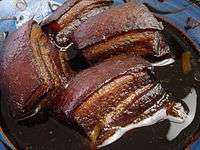Huaiyang cuisine
Huaiyang cuisine (淮揚菜) is one of the Four Great Traditions in Chinese cuisine. It is derived from the native cooking styles of the region surrounding the lower reaches of the Huai and Yangtze rivers and centered on the cities of Huai'an, Yangzhou and Zhenjiang in Jiangsu Province. Although it is one of several sub-regional styles within Jiangsu cuisine, Huaiyang cuisine is widely seen in Chinese culinary circles[1] as the most popular and prestigious style of Jiangsu cuisine – to a point where it is considered to be one of the Four Great Traditions (四大菜系; Sì dà càixì) that dominate the culinary heritage of China, along with Cantonese cuisine, Shandong cuisine and Sichuan cuisine.
| Huaiyang cuisine | |||||||
|---|---|---|---|---|---|---|---|
| Traditional Chinese | 淮揚菜 | ||||||
| Simplified Chinese | 淮扬菜 | ||||||
| |||||||
 |
| Chinese cuisine |
|---|
|
|
Overseas cuisine |
|
Ingredients and types of food |
|
Typical features
Huaiyang cuisine is characterized by basing each dish on its main ingredient; the way that ingredient is cut is pivotal to its cooking and its final taste. The cuisine is also known for employing Chinkiang vinegar, which is produced in the Jiangsu region. Huaiyang cuisine tends to have a slightly sweet side to it and is almost never spicy, in contrast to some cuisines of China (like Sichuan or Hunan). Pork, freshwater fish and other aquatic creatures serve as the meat base in most dishes, which are usually more meticulous and light.
Notable dishes
Huaiyang cuisine also includes several breakfast choices such as crab soup dumplings (蟹黃湯包; xìehúang tāngbāo), thousand-layer cake (千層糕; qiāncéng gāo), steamed dumplings (蒸餃; zhēngjiǎo), and wild vegetable steamed buns (野菜包子; yěcài bāozi).
Other standard dishes of Huaiyang cuisine include:
| English | Image | Traditional Chinese | Simplified Chinese | Pinyin | Notes |
|---|---|---|---|---|---|
| Dazhu gansi | 大煮乾絲 | 大煮干丝 | dàzhǔ gānsī | Finely cut chicken, ham and dried tofu in chicken broth | |
| Jade shaomai |  | 翡翠燒賣 | 翡翠烧卖 | fěicùi shāomài | |
| Lion's head |  | 獅子頭 | 狮子头 | shīzi tóu | Braised pork meatballs in brown sauce |
| Noodles with shrimp and pork dumplings | 蝦子餃麪 | 虾子饺面 | xīazi jǐaomiàn | ||
| Pot stickers |  | 鮮肉鍋貼 | 鲜肉锅贴 | xiānròu gūotīe | |
| Sliced fatty pork slices |  | 厚皮香豬 | 厚皮香猪 | hòupí xīangzhū | |
| Yangchow fried rice |  | 揚州炒飯 | 扬州炒饭 | Yángzhōu chǎofàn | |
Others include Yangzhou pickles, baozi, gansi (sliced tofu), sticky candy, ginkgo, Qionghuayu liquor, Nanshan green tea, baoying lotus root starch, and Jiangdu short pastry.
Baozi is a type of steamed bun with meat or paste fillings. It is sometimes served for breakfast and is best eaten hot.
There is also a dish called "Beggar's Chicken" (叫化雞; jiàohuā jī), which is a whole chicken marinated with spices and wrapped in aluminum foil. Contrary to its name, it is not the food for the homeless. Traditionally, beggar's chicken is wrapped in leaves or sometimes even in mud, thus allowing the full flavor of the chicken to be preserved.
Because Yangzhou is close to Nanjing, people will be able to enjoy the mix of northern and southern cuisines. When in Nanjing, one unusual local dish is duck blood and vermicelli soup, consisting of congealed duck's blood in noodle soup, another is its stinky tofu.
Use in official dining
Huaiyang cuisine has been employed in official occasions by the Chinese government. Some examples include:
- In 1949, for the first state banquet of the People's Republic of China.
- In 1999, for China's 50th anniversary state banquet.
- In 2002, for visiting U.S. President George W. Bush, hosted by Chinese President Jiang Zemin.
See also
References
- Edward, Ragg. "China - The perfect wine match for Chinese food".